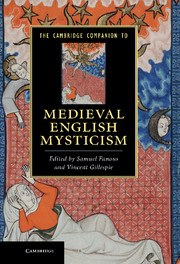Book contents
- Frontmatter
- Contents
- List of contributors
- Preface
- Chronology
- List of abbreviations
- 1 Introduction
- 2 c. 1080–1215: culture and history
- 3 c. 1080–1215: texts
- 4 1215–1349: culture and history
- 5 1215–1349: texts
- 6 1349–1412: culture and history
- 7 1349–1412: texts
- 8 1412–1534: culture and history
- 9 1412–1534: texts
- 10 1534–1550s: culture and history
- 11 1534–1550s: texts
- Guide to further reading
- Glossary of theological terms
- Index
- References
11 - 1534–1550s: texts
Published online by Cambridge University Press: 28 July 2011
- Frontmatter
- Contents
- List of contributors
- Preface
- Chronology
- List of abbreviations
- 1 Introduction
- 2 c. 1080–1215: culture and history
- 3 c. 1080–1215: texts
- 4 1215–1349: culture and history
- 5 1215–1349: texts
- 6 1349–1412: culture and history
- 7 1349–1412: texts
- 8 1412–1534: culture and history
- 9 1412–1534: texts
- 10 1534–1550s: culture and history
- 11 1534–1550s: texts
- Guide to further reading
- Glossary of theological terms
- Index
- References
Summary
Post-Reformation recusant institutions produced exceptionally important witnesses to the pre-Reformation English mystical tradition. Those same offshore institutions also produced some new contemplative texts of their own, as did some very isolated figures still in England. Despite this preservation and production, however, the mystical tradition was under immense cultural and political pressure in post-Reformation English culture. Already in the pre-Reformation period there are powerful signs of new devotional traditions that eschew the resources of mystical writing. Post-Reformation, the mystical tradition becomes a tenuous stream, barely surviving in a largely hostile environment.
The execution of Elizabeth Barton (known as ‘The Holy Maid of Kent’), on 20 April 1534, might serve to mark the new and hostile climate with which English ‘mystical’ writings were obliged to contend. Elizabeth Barton (born c. 1506) was almost certainly illiterate, but in 1525 experienced visions; these were taken seriously enough by Archbishop Warham that Barton was admitted to the Benedictine priory of St Sepulchre, Canterbury. By 1527 she had taken her vows. Warham sent an account of her revelations to Henry VIII, and in the late 1520s she was the object of sympathetic interest by the king and his closest advisors. In 1530, however, she prophesied disaster for the king should he divorce Katherine of Aragon. Barton was convicted of high treason in 1534, and subsequently hanged and beheaded, along with others involved in her case; John Fisher, bishop of Rochester, was also implicated, and imprisoned at the king's pleasure.
- Type
- Chapter
- Information
- The Cambridge Companion to Medieval English Mysticism , pp. 249 - 264Publisher: Cambridge University PressPrint publication year: 2011
References
- 1
- Cited by

